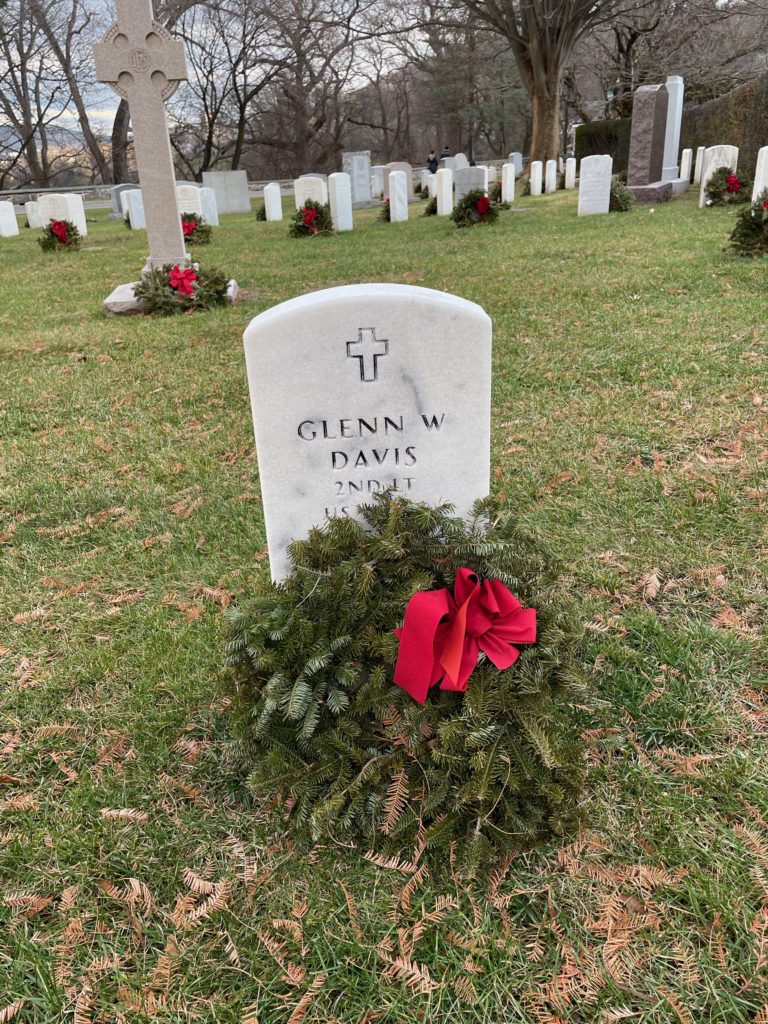Erik Visits an American Grave, Part 1,243
This is the grave of Glenn Davis.

Born in 1924 in Claremont, California, Davis was a great high school football player out there, leading his team to a state title in 1942. This was in the middle of World War II, so one would think Davis would head to the military immediately. You’d be right….sort of. Davis was recruited to play at Army. At this time, the service academies recruited a lot more directly than they do today and you really didn’t have to have the grades you need today to play there. These were dominant teams, the power structure of the military wanted it that way, and so Davis got to avoid the war by going to West Point and playing football.
Well, Davis became perhaps the most dominant college football player of his generation while at Army. He started at fullback but then was moved to halfback as a sophomore, while the nearly as great Doc Blanchard moved to fullback. This was an utterly dominant running attack at the peak of the running attack being what mattered in football. The teams were great–they won the national title in each of Davis’ three last years there, from 1944 to 1946. In 1945, Davis averaged over 11 yards per carry, which still remains the single season record today. He also holds the all-time record, with over 8 yards per carry. He and Blanchard set the teammate rushing touchdown record as well with 97, though the great Pete Carroll coached USC teams with Reggie Bush and Lendale White broke that with 99.
Davis was a consensus All-American three times. In 1944, he won the Maxwell and Walter Camp trophies, but was only second for the Heisman. Blanchard won the Heisman in 1945 and Davis was second again. But Davis did win the Heisman in 1946. He also was the AP Male Athlete of the Year in 1946.
In 1947, Davis graduated and he needed to serve his time in the military. As he was in there after World War II and before Korea, he got out without seeing any action. He didn’t want to serve at all. He hated it, by most accounts. All he wanted was to play football at the highest level, which is why he went to Army in the first place. Perhaps he regretted it in the end because it meant he wouldn’t have much of an NFL career. He was a good enough baseball player that the New York Giants offered him a contract, but he declined it, knowing that he would be old for baseball when he could actually play and he wanted to play football anyway. The Detroit Lions drafted him with the second pick in the 1947 NFL draft. Just before the season, the Lions traded Davis’ rights to the Los Angeles Rams. Davis appealed to the military to let him out of the service so he could play football. That was not happening. Secretary of the Army Kenneth Royall personally refused it. Davis tried to compromise, asking about furloughs and such that could be made up later. Nope.
Davis finally got out of the Army in 1950. But he was a shell of what he could have been. In 1947, Davis and Blanchard were paid $25,000 and given permission by the military to take some time to make a film called The Spirit of West Point, which was a B-movie that promoted the glories of the Academy and its football team as a collaboration with Hollywood. Alan Hale, Jr., i.e., the Skipper from Gilligan’s Island, is in it too. Well, during the making of it, in one of the football scenes, Davis tore up his knee. Maybe it was an ACL injury, not sure they ever knew.
Davis was sort of recovered by 1950, but did not have the ability he once did. He had an OK rookie season, more as a pass catching running back than a powerful runner at this point. He was named to the Pro Bowl. Then he tore up his knee for a second time in 1951. He tried to come back in 1953, but he was done. The Rams released him and that was the end for one of the great running backs of all time. He was a big enough star even in these days to live a playboy life. He dated Elizabeth Taylor even! He married the somewhat lesser known actress Terry Moore, who was once nominated for a Best Supporting Actress Oscar in 1952 for Come Back, Little Sheba, but that marriage didn’t last long.
Davis was a bit lost after that. He tried his hand in the oil business for a bit, but had no success. The Los Angeles Times eventually hired him to run its charity events. He was a big name and could just be Glenn Davis, Football Star. People could get their picture taken with a legend, he could feel good about himself, kind of perfect for that kind of position. He held that job all the way until 1987, when he retired.
Davis died of prostate cancer in 2005. He was 80 years old.
Glenn Davis is buried in United States Military Academy Post Cemetery, West Point, New York.
If you would like this series to visit other Heisman winners, you can donate to cover the required expenses here. Joe Bellino, who won the 1960 Heisman as a running back for Navy, is in Annapolis, and Bruce Smith, who won the 1941 Heisman as a running back for Minnesota, is in Minneapolis. Previous posts in this series are archived here.


